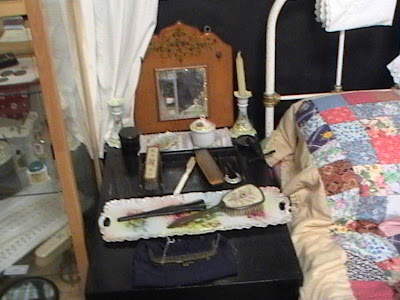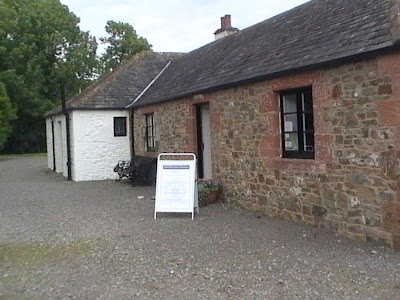 The Ruthwell Cross
The Ruthwell CrossThese pieces remained in the Churchyard until a minister Dr Henry Duncan came along in 1799. He marvelled at these wonderful pieces of sculpture and determined to find out all about them. It became his mission to restore the beautiful Cross, to its original state.
But what to do about the missing crossbeam?
Henry Duncan researched the matter and together with a local mason came up with the design as it now stands.
Eventually it was complete, but although times had changed since the Reformation it was still deemed unsuitable to erect the Cross within the area of the Church. Henry got around this by erecting it in the garden of the Manse (Scottish name for the vicarage).
But then through time the vagaries of the Scottish weather were working against the preservation, and the sculpture was beginning to suffer.
In 1871 a new minister Rev James Caplin realised this and saw that if the Cross were to survive it had to go indoors. By this time it had become world renowned, and this project had the backing of prominent scholars from within Scotland and beyond. In the Year of Queen Victoria's Jubilee, 1887, it was taken in to Ruthwell Church. As it was too tall to be erected without raising the roof of the building a compromise was reached and a pit dug into the floor to house the beautiful Cross.
Detail on the Cross
The Visitation
The new Crossbeam with Archer underneath
Landscape around the Church
A brief description of the Cross.
Thicker at the base it tapers to the Crossbeam.
Jesus is always portrayed with a halo inside which is the shape of the Cross, other dignitaries whilst being depicted with halos, do not have a cross inside them.
It is thought that the Master Carver left some of the lesser work to an assistant, as some of the figures do not exhibit the same level of skill. The Master Carver however always carved the images of Jesus.
When the Cross was reconstructed it is thought that some of the parts may have been incorrectly placed.
Vine Scrolls can be seen in many European countries, especially in the Catacombs in Rome. The examples on the Ruthwell Cross far outshine the workmanship of those anywhere else.
There are also wonderful depictions of animals on the Cross. Look for lizards, pigs, eagle, dove...
The Story the Cross Tells
It tells of St John The Evangelist, and shows his emblem the Eagle.
One can see an act of penance where a woman washes Jesus' feet.
Also it tells of the Annunciation where Angel Gabriel tells Mary she will give birth to Jesus.
One can see the Visitation scene, where Mary goes to visit her cousin Elizabeth who is pregnant with her son who will be known to all as John The Baptist. The baby in the womb is said to have leapt with Joy when Mary came to visit.
There is a scene of the flight into Egypt, showing Mary and the Baby Jesus riding on a donkey.
At the base, there is a scene of the Cruxifiction.
Jesus is shown in one section standing on what looks like pigs, which illustrates the triumph of good over evil.
Two of the Evangelists are shown.
John the Baptist is depicted with the Lamb of God, his feet are placed on two orbs.
Another scene shows Paul meeting Anthony, a hermit, in the desert.
The Story of Jesus is there for all to see, and the message of the Ruthwell Cross will carry on down through the generations for all of time.
My Next post will pose a question.









































